WinHEC 2005: Coverage Wrap
by Derek Wilson & Jarred Walton on April 29, 2005 2:00 PM EST- Posted in
- Trade Shows
Prototype Media Devices
We've snapped pictures of some of the units that were being demonstrated at the show that were targeting the media center audience. There are of course numerous ways in which to approach such a market, but we'll be focusing here on the more unique designs. Probably half to two-thirds of the booths in the Expo Hall had a media device present, with one to many streams of HD and/or DVD content all running in real time.Texas Instruments
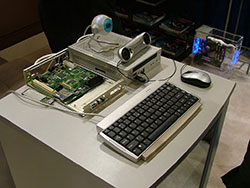 |
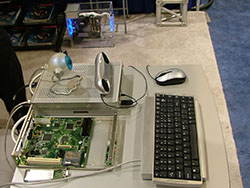 |
| Click to enlarge | |
Texas Instruments was demonstrating this "Split Chassis PC Product". While the main system was a standard PC connected to an HDTV, the small module you see above was connected to the main system via an X1 PCIe cable. With a bidirectional data rate of 2.5 Gbps (250 MBps data throughput, as 62.5 MBps is used for communication overhead), the connection is more than capable of handling all of the necessary traffic. The end result is that the large media processing PC can be stored out of sight and the only visible interface is this small box, roughly the size of a typical 5.25" DVD drive (2x7x10 inches). Keyboard, mouse, USB, Firewire, and audio connections are all present on the "I/O Hub", along with IDE and CardBus/PCMCIA and a flash card reader.
Texas Instruments feels this provides a compelling solution, with the PCIe X1 cable providing up to 7 meters of distance between the main PC and the I/O Hub. The PC still needs to be close enough to connect to your HDTV, of course, which is a limitation of the DVI or component video cables that are used. There are certainly some interesting use cases for the design, i.e. a console located in a unit next to your sofa with the noisy PC placed where it can be neither seen nor heard. Couch potatoes of the world will rejoice at the ability to change a DVD without ever standing up!
Embedded Device Processors
While the Athlon and Pentium processors receive the lion's share of attention these days, there are still many alternative processors that can be used for media devices. Intel has the XScale architecture, which is non-x86 - it's an extension of the ARM5TE architecture. There may have been some devices using this processor, but we didn't notice any. Moving on, AMD has their Geode GX and NX processors, VIA has the Eden CPU as well as a new Luke processor, and Transmeta has their Efficeon processors. We've got images of some prototypes for all of these platforms.AMD Geode
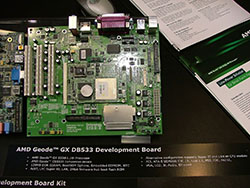 |
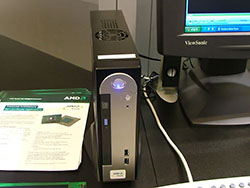 |
| Click to enlarge | |
Starting with AMD, the Geode processor is designed as a low power embedded solution. The GX model shown above-left consumes a miniscule 1.1W at 533 MHz. For video content, a hardware decode/encode chip would be required for most formats. The NX is a higher performance version, as well as a higher power device. We didn't get a clear shot of the screen, but DVD quality video was being decoded without problems from the system on the right. Without some additional hardware assistance, HD content would probably have difficulty, however.
Transmeta Efficeon
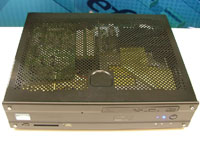 |
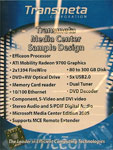 |
 |
| Click to enlarge | ||
Our next stop was at the Transmeta booth, where they were demonstrating their 100% silent media center sample. You can see the internal components as well as their exterior. According to the booth personnel, the sample unit was designed and built for the show in only a few months using mostly off-the-shelf hardware. A couple of the more interesting aspects are the use of a dual-tuner card (that's the large add-in card you see on the left of the image), allowing for recording one channel while a second is being watched. We're not convinced about the need to handle 4+ simultaneous streams, but there is definitely a good use case for handling at least two streams.
It's also interesting to note that a Mobility Radeon 9700 was used in their prototype, which is probably a lot more power than most companies would put into a media center device. On the other hand, that does give them the ability to handle Longhorn (with the Aero Glass UI) once it ships. With no fans on the system, it should be totally silent (other than perhaps the DVD drive when it's in use) - not that we could verify this over the crowd noise. However, we're a bit concerned about long-term reliability, and a single temperature sensitive, low-RPM fan might be a useful addition. This would help to guarantee that the HDD and other components are kept cool, helping to increase their lifespan. This can be particularly important during the summer months.
VIA Eden and Luke
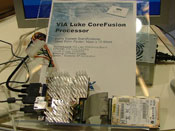 |
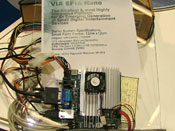 |
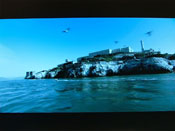 |
| Click to enlarge | ||
Our last examples for media center devices come from VIA. The Eden processor has been around for quite some time, but this was the first we had heard of the Luke processor. Basically, it was their North Bridge solution with the Eden integrated - and we say it that way rather than the Eden with an integrated NB as the NB is roughly 3X the size of the CPU! The whole board is covered by a passive heat sink, but you'll note the small size of the board: 10cm x 10.5cm; it's not much larger than the attached 1.8" HDD. While the Luke setup was only shown powering XP, a nearby Nano platform was shown decoding 720p HDTV without trouble. (The photo is blurry due to our camera and photography skills, not the LCD or platform.) Via touts the Nano platform as being the "most highly integrated platform for small digital entertainment devices," and at 12cm x 12cm it certainly isn't large. Now they just need to clean up their wiring....
VIA SMP Eden
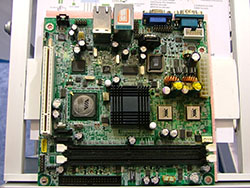 |
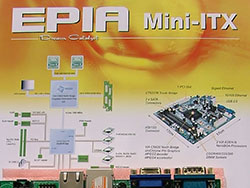 |
| Click to enlarge | |
We didn't get a shot of the working prototype system (well, we did but it was so blurry that it was unusable), but we did get some photos of the board and specs for VIA's take on the SMP market. That's not how they described it, but we thought the dual-processor Eden setup was rather intriguing. At 17cm x 17cm, it's larger than their other demo platforms, but it also includes quite a few more features. Besides the two Eden CPUs, it has GbE along with a second 10/100 Ethernet port, two DIMM slots, 2 x SATA and 1 x IDE, and the CN400 NB (integrated UniChrome Pro graphics, hardware support for MPEG2 decoding, and MPEG4 acceleration). It's basically the same as the Nano platform but with SMP and a larger board. Two Eden chips aren't going to set any performance records, but then the target market isn't really about raw performance. Anyway, we thought it was pretty cool, considering the small size of the CPU connections and the low heat output. Maybe a Luke-II CPU can incorporate both cores with the chipset?
SaintSong
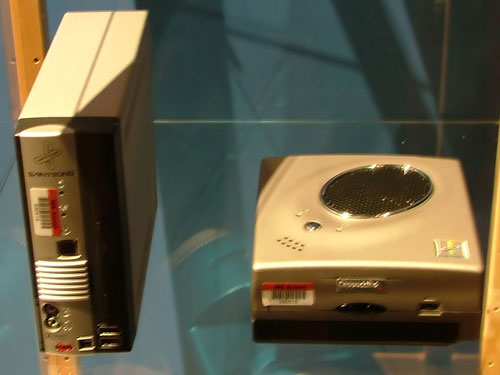
Here's a final shot of a couple small units from a company called SaintSong that were in the hardware showcase. We're not even sure what the specs are, but they're just barely thicker than a typical 5.25" DVD-RW drive while not being quite as long. Assuming the price, performance and features can at least match the Mac Mini - with perhaps better media support - we're sure there will be some interested buyers.
Just to reiterate, these are all prototype or reference designs at best. Interested vendors could add or remove features from any of these platforms in order to meet the demands of their target market. We may never see any of these specific units for sale, but the concepts presented could easily show up in next generation cable/set-top boxes. Microsoft's vision of a digital home is going to require a lot more than large ATX-size PCs, and these smaller devices are meant to fill those roles.










17 Comments
View All Comments
JarredWalton - Wednesday, May 18, 2005 - link
JimmyTalbot, the Avalon cylinder demo was done on a laptop for us but one of the developers. It was basically meant as a "proof of concept". She said it took about one or two days to create - i.e. it was much easier than current Windows APIs. As far as I know, it's not available to the public or anyone outside of MS. Sorry.JimmyTalbot - Monday, May 16, 2005 - link
I should have specified: I got the WinFX (Avalon) Beta SDK hoping to find the sample in there, but it's not included.JimmyTalbot - Monday, May 16, 2005 - link
Does anybody know if/where I can get the "3D Picture Viewer" demo shown on page 1 of the article?Doormat - Monday, May 2, 2005 - link
I think the idea of browsing in the BIOS is fascinating. Even with WinXP its still 1-3 minutes or so to get to a usable browser or mail program. If all you needed to do is check your mail real quick, why not just go into the BIOS and forget about booting all the way into windows, and then shutting down.Fricardo - Monday, May 2, 2005 - link
"The other interesting comment from Barry was that he stated AMD will be using DDR2 in a future processor. We had asked if they might simply skip DDR2 altogether and head straight to DDR3, and he said they would not be doing so."Now that is interesting. I've been wanting to know that for months. Strange how the most useful part of the article was a talk with an AMD employee. Thanks guys.
Tujan - Sunday, May 1, 2005 - link
The funny thing about Windows is that the development areas seem oblivious to fact that testing of succesful programs are done on high-end systems wich then we see with the OEMs giving underperforming system to the masses.The graphics ideas are great,sure,but on 'when''the default graphics will be able to take and PASS the test the big boys are working with.
Windows interface for Longhorn,sure looks like the same barnyard.So we will have to rely on other vendors, and programs such as WindowsBlinds to add deriviative to such things as different colored buttons in a dialog box.
Again why so,a system font size cascades 'all windows.Nothwithstanding,getting pass security to customize your own computer now. Why does the interface remain nothing more than a very expensive colored lightbulb,and a glorified printer.
Hello,'integrate the icons into the 'program ? Sure we see the 'how-it-works. But why does it have to work at all.Is this going to keep us from creating our own icons for our own 'visual aids.Wich most all of retails off-the-shelf instructions for 'Long Horn,will invariably be in print.Now just imagine the trees for example.
So why dont you integrate the add/remove programs to the 'File Associations.? Isn't this explicit enough to keep from having those undocked windows fish flying from one pond to another.
Get rid of DOS.Think the learning expression traveling this train is simply to head for the caboos,and jump off.You would certainly be at the conductors point of reference then right ?
Im ready for a Virtual windows machine running technology all the way to the 60s.But we in the real computer world only imagine.Imagine that syntax doesn't come with noun,verb,subject and predicate. Much less have a reference that tells you so. Rather than giving somebody the rug by saying lets do the media,then I told you so.
Good luck.And wheres the beef ?
DerekWilson - Sunday, May 1, 2005 - link
In hind sight, Anand is probably right about Longhorn being more advanced than Tiger ... But the direction and (lacking) demos we saw didn't give us the warm fuzzy feeling we would expect.Of course, the ammount of cash Microsoft has laying around to make something happen if they need to would make anything possible ... My real question is: do they think they need to?
Give both Apple and MS a year and a half, and we could have an interesting feature battle on our hands depending on how much Apple can push themselves and how much MS cares :-)
Icehawk - Saturday, April 30, 2005 - link
I'm very curious as to how the UEFI Bios works, very intriguing to me.***
I think it is interesting that in Anand's Tiger article he says that Longhorn should be more advanced but this articles suggests it will be at on par, at best. I wonder which it will be?
***
3D on servers? Now that is a waste of resources and money. If a particular app uses it, OK then I'll budget the resources. But why should I need 3D to run IIS/FTP/etc?!
Well software wouldn't be anywhere without hardware, would it?
The market is pretty stagnant right now so I guess pushing 3D onto all desktops and making a gpu/cpu intensive OS should ensure some huge rounds of upgrades. Server-side almost none of them have 3d cards, or if they do very weak built-ins for the most part. On the desktop a P3 1ghz with 512mb of RAM is still *passable* on XP, that is a 5 year old machine. Something even slightly more robust like a 1.4ghz K7 with 1gb of RAM still runs everything but games without too many issues.
Guess they need to do something to make me want to upgrade again - I just went from that 1.4 K7/GF4 to a 3.2 P4/6600GT and don't see any offerings on the 1-2yr horizon causing me to upgrade otherwise. DC would be nice with my usage but raw processing power...? Only in games. That was the only reason I upgraded at all now, I would have waited if I could have otherwise as my old machine ran everything up until D3/HL2 fairly well.
stephenbrooks - Saturday, April 30, 2005 - link
...or post comments while you're in your BIOS.xtknight - Saturday, April 30, 2005 - link
awesome...I can't wait to get ahold of a WGF2.0 card and Longhorn. sounds like that will provide for some awesome effects I could put in my programs. UEFI looks kinda interesting as well. web browser in a BIOS is going too far IMO, though. they need to keep in mind this is just for diagnosing your pc. on the other hand you could download drivers or search for troubleshooting information from anandtech forums, while you're in your BIOS :)